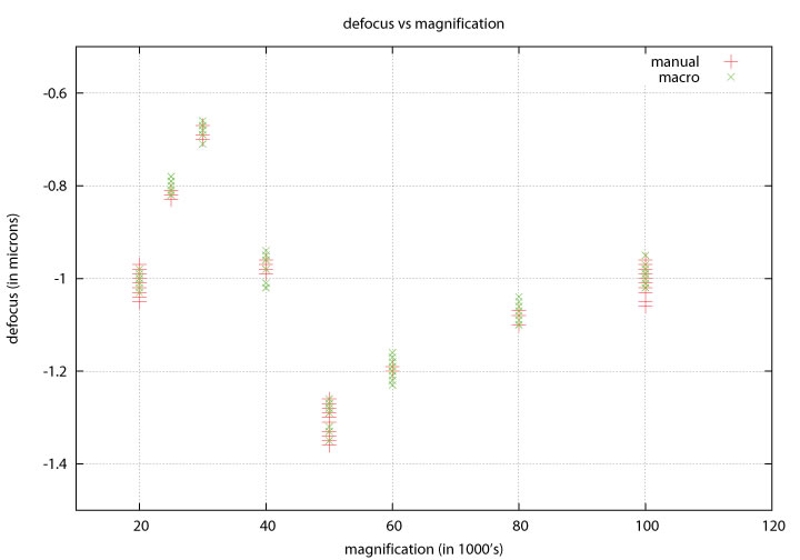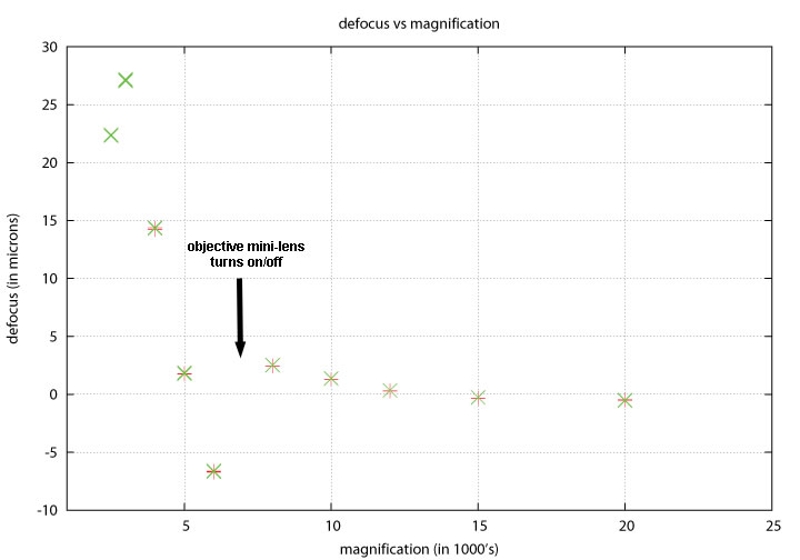In an ideal magnification system, once the user has set the focus at a particular value, that value should not change if/when the magnification is varied. Such a system would be described as perfectly parfocal, and indeed bright field light microscope lenses, telescopes and high quality photographic zoom lenses are (nearly) perfectly parfocal. Another desirable property of systems that can vary their magnification is that every time the instrument is returned to the same magnification setting, the device will produce images with exactly the same magnification. Unfortunately for users of transmission electron microscopes (TEMs), the lenses used in these instruments do not have these properties. These issues will be illustrated using data acquired on the Electron Microscopy Center's JEOL JEM 3200FS.
Interplay of Magnification and Focus
Deviation from Parfocality
Unfortunately for electron microscope users, electron microscope lenses are generally not perfectly parfocal (and older TEM's were not ever close to being parfocal). In other words, there will be a defocus change associated with changing the magnification in most (perhaps all) TEM's. That was the bad news. The good news is that TEM's are generally close to parfocal (i.e., most small changes in magnification will cause small changes in defocus) and (more importantly) defocus changes associated with changing magnifications are consistent over time. In other words, a user should be able to set the defocus at (for example) 200,000x, lower the magnification to 50,000x and predict accurately what the defocus at the lower magnification will be. The following series of graphs show what is seen when a particular defocus is set on the 3200FS, the magnification is varied and defocus at a new magnification is measured.

In the plot above, serialEM was used to set the defocus at -1.0 microns at 20,000x and then used to measure the defocus as the magnification was changed from 20,000x to 100,000x and back. In this study, there was no measurable difference between the defocus at 20,000x and 100,000x and defocus was actually set at either end of the magnification range and then measured when moving towards the opposite end of the range. The red +'s were generated by manually changing microscope settings and using serialEM to measure the defocus while the green x's were generated using a rather simple serialEM macro to change the magnification and measure the defocus while starting at one magnification and moving a set number of mag steps up or down in magnification.
It is clear from this plot that the instrument is not parfocal (for example, there are changes of greater than ~30% in the defocus at magnifications of 30,000x and 50,000x). However, it is also clear that over the course of this work, the changes in defocus were rather consistent (i.e., over the course of the work, the measured defocus is quite reproducible when returning again and again to the same mafgnification). It should also be noted that over this magnification range, the changes in defocus from one magnification to the next are relatively small in terms of absolute defocus changes (less than 0.5 μm at most, with many less than 0.2 μm).

In the plot above, the green x's and red +'s represent two runs of the serialEM macro mentioned above. The defocus was set to -0.5 microns at 20,000x and then defocus was measured as the magnification was lowered to 2500x (the lowest magnification in the "mag mode" of our 3200FS). The variation in measured defocus is small enough that the "single" X's and +'s are actually multiple measurements that are too tightly packed to see as individual markers (i.e., there are five measurements for the defocus at each magnification). Once again, the 3200FS is not parfocal, and is especially not parfocal in the very lowest magnification ranges. This is likely to be (somewhat) deliberate on the part of JEOL: by increasing the defocus at the lowest magnifications, the contrast increases significantly and it is possible to see things!
Another thing to keep in mind is that with the 3200FS, as the mag changes between 6000x to 8000x, the objective mini-lens turns on (when going in the low mag direction) or turns off (when going in the high mag direction). Several things happen at this point, including a significant change in image rotation and the large change in defocus (i.e., the first really large deviation from the defocus set at 20,000x is at this transition point).
Deviation from Reproducibility
Content coming soon...

